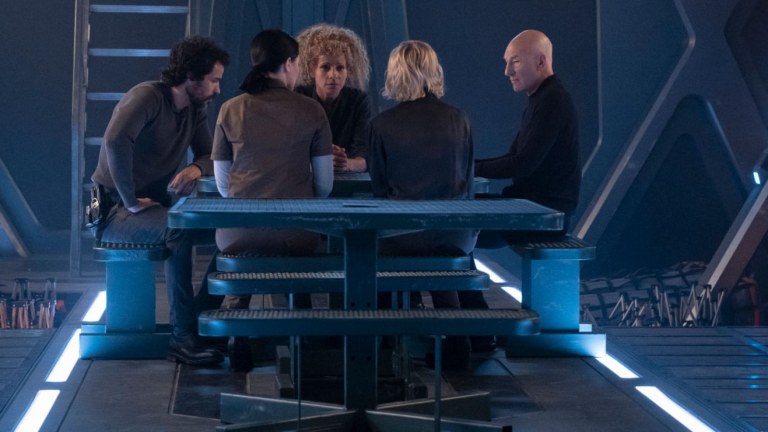Star Trek: Picard is All About Finding a Family
Star Trek: Picard's emphasis on found family is what sets it apart from most other Trek, especially as it moves into Season 2.

Warning: This Star Trek: Picard article contains spoilers through the end of Season 1.
The mere existence of a show named Star Trek: Picard is naturally going to bring up questions of legacy, particularly given that the series was initially positioned as a second act for the character made famous by Star Trek: The Next Generation. And, on some level, the show leans into that idea, peppering virtually every episode with returning characters, narrative callbacks, and other appealing bits of nostalgia.
But Picard isn’t terribly interested in telling a story about the past. This isn’t a Lear-esque drama about a once great man facing down the twilight of his life or reckoning with his own hubris. (Though there are definitely important moments of this sort of introspection involved.) Instead, this is a sequel that spends the bulk of its time looking forward, not back; ultimately establishing an origin story for a series that is generally nothing like the one that preceded it. (This is a good thing, by the way.)
Yes, iconic Star Trek captain Jean-Luc Picard is the linchpin around which Picard turns, but this show is not solely about his journey. It is also the tale of the found family of outcasts and lost souls that he assembles along the way, a group that desperately needs the hope provided by his relentless optimism and the purpose offered by his insistence that it’s not too late for them to choose their better angels or to become their best selves.
Unlike every other Star Trek show that has come before, Picard did not arrive fully formed. On shows like Star Trek: Discovery or the The Next Generation, the crew of our central starship is firmly established from the very beginning. Of course, those characters inevitably grow and change, bonding by virtue of shared experiences on board their various ships and dealing with challenges along the way. But they’re all starting from a similar point of reference – they’ve all been to Starfleet Academy and they basically know the basics of what to expect from their journeys. It’s what they signed up for, after all.
In Picard, not so much. This story begins with Picard alone on the vineyard he never wanted to inherit in the first place. (Aside from his dog and his sparse household staff, who appear to be his only real friends.) He eventually finds himself back amongst the stars to search for the long-lost daughter of the synthetic human he once called his best friend – an act that he undertakes in direct contradiction of Starfleet’s existing laws and protocols. And, as the series continues, he picks up a ragtag group of increasingly broken people, who all have their own demons to fight.
There’s Rios, a second-rate ship’s captain who has created a squadron of holographic service doppelgangers in his own image rather than interact with anyone who might make him face his dark Starfleet past. There’s Raffi, Picard’s burnout BFF from the final days of his career as an admiral, who self-medicates her grief over the son that’s rejected her with an assortment of drugs. And there’s Elnor, a perfect cinnamon roll with serious Daddy issues that Picard once abandoned to the care of a group of warrior nuns as a child. And all that’s before we get to the former Borg turned galactic vigilante, or the brilliant doctor who basically joined a Romulan death cult.
These people don’t need Starfleet protocols. They need therapy.
Yet, these outcasts find a common bond and a common purpose together. And somehow, it’s through one another that they begin to heal. Picard, Rios, and the crew of the La Sirena set off with what appears to be a simple enough goal: Rescue Soji before she meets the same awful death that found her twin sister, Dahj. Of course, doing so requires they stage a heist, visit a repurposed Borg cube, run away from some Romulans and make first contact with a planet of synths living in defiance of the ban that had been previously placed upon them after the devastating Mars disaster.
It’s as messy as it sounds. In fact, the overarching plot of Picard doesn’t always make a ton of sense. Over the course of the season, it’s far too easy to lose the thread of the Romulan story – who was chasing and/or betraying whom, which side Soji’s dirtbag ex-boyfriend Narek was on at any given moment, whether she was truly destined to become an apocalyptic destroyer of worlds or precisely who was trying to kill or kidnap her during any particular episode.
Thankfully, Picard is really a story about its characters, so you don’t need to feel that bad about not caring about the complicated hierarchy of the Romulan empire. Because what we’re watching isn’t ultimately a story about Romulans, or even synthetics. (Even though perhaps we should spend a bit more time on the idea that Picard himself isn’t exactly human anymore by season’s end, just saying.) What we’re actually witnessing is the formation of a family, assembled piecemeal from a group of people that find in one another something to believe in.
“That’s the whole point. That’s why we’re here: to save each other,” Picard tells Soji while he’s begging her not to summon a raft of vicious space snakes and destroy a big chunk (or possibly all?) of humanity.
This is a philosophy that Picard embraces on both a macro and micro level. Every member of the La Sirena is, in some way, fighting a complicated and uphill emotional battle, often involving dark histories. Agnes must reckon with the fact that she killed a man she once purported to love. Seven of Nine repeatedly confronts her Borg past this season – even going so far as to reconnect to the collective in order to help rescue a boy and a people she barely knows. Raffi begins the slow climb out of addiction and back to herself, while Rios finally starts to process his grief and anger over his former Starfleet captain who killed himself. And Soji, of course, discovers that everything she’s known about her life is a lie.
Picard’s final, moving speech to Soji is not just a great character moment for them both, but a reminder of what we owe to one another, in a larger sense. Soji’s choice is a powerful one – to trust that humanity has more good days than bad ones, and that, together, we can help lift one another up. And each member of the La Sirena makes an equally powerful – if quieter – choice. Together, they can help each other be better than they were before
In the end, each of these characters choose one another. The final shot of the finale is of our ramshackle new crew, sporting Starfleet insignia and taking up their positions in a world they’ve made for themselves out of pieces that really shouldn’t fit together at all, but do. What will their story look like in Season 2, now that they’re firmly a family? It’s difficult to say just yet, but this little starship family looks vastly different from every version that’s come before. It seems safe to say their journey will too.
